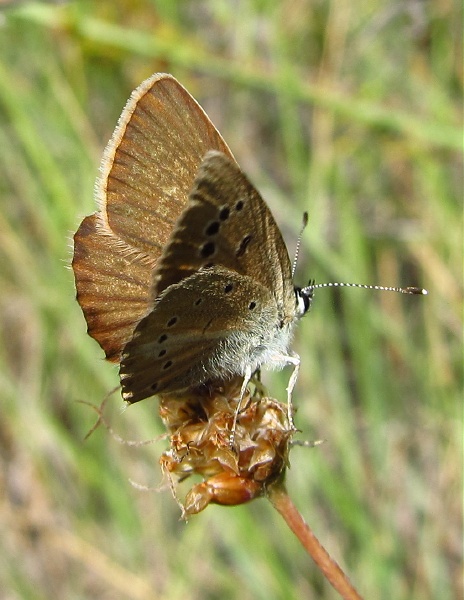
Male, Aragón, July 2011

Males, Aragón, July 2017. The one in the centre is typical
ripartii.
The other two are what I identify as ssp.
agenjoi, though
this is problematic.

Male, Aragón, July 2011

Male, Aragón, July 2011

Female, Aragón, July 2011

Female, Aragón, July 2011

Female, Aragón, July 2011

Distribution
This is the most widespread
of the
anomalous blues, though some of its scattered populations have
historically been ascribed specific status (and still are by some
authors). I have only seen it in Spain, in a region where two
subspecies seem to overlap. This is problematic and I am unsure what is
really going on. The individuals on this page correspond to classic,
Spanish
ripartii.
Others, which I illustrate on my
agenjoi
page, match the descriptions of that taxon (formerly considered a
species) exactly. These are on average slightly smaller and have
shorter white stripes on the underside. Most likely, this is simply a
very variable species even within one location.
Both
male and female anomalous blues are plain brown above. Where only one
species flies, this makes males
easy to identify because males of other, closely related
groups, such as furry blues, are blue above. Male Ripart's anomalous
blues have a prominent white streak on the underside hindwing and are
usually a rather powdery white in colour beneath both wings. The upper
surface of
the forewing has striking androconial cells, clearly visible in the
first picture above and even more clearly in my pictures of
Agenjo's
anomalous blue.
Females are harder to identify, especially when they fly (as they did
where I found them in Spain) in the company of Forster's furry blues. I
have studied hundreds of pictures of both species (of pinned specimens,
so ID confirmed) and although I have noticed statistically significant
differences I have found nothing that always works. I believe the
pictures of females above are of Ripart's anomalous blue but all were
flying in the company of Forster's furry blue.
The species flies in a single brood from June to August in grassy,
flowery places where the foodplant, various species of sainfoin,
grows.The caterpillar hibernates while small, presumably to avoid the
dessicating heat of the southern European summer.











